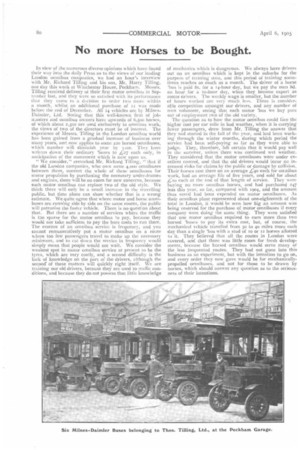No more Horses to be Bought.
Page 8

If you've noticed an error in this article please click here to report it so we can fix it.
In view of the numerous diverse opinions which have found their way into the daily Press as to the views of our leading London omnibus companies, we had an hour's interview with Mr, Richard Tilling and his son, Mr, Harry Tilling, one day this week at Winchester House, Peckham. Messrs. Tilling received delivery of their first motor omnibus in September last, and they were so satisfied with its performance that they came to a decision to order two more within a month, whilst an additional purchase of ot was made before the end of December. All 14 vehicles are by MilnesDaimler, Ltd. Seeing that this well-known firm of jobmasters and omnibus owners have upwards of 6,500 horses, of which about 2,5oo are used exclusively in omnibus work, the views of two of the directors must be of interest. The experience of Messrs. Tilling in the London omnibus world has been gained from a gradual increase of business over many years, and ROW applies to some 220 horsed omnibuses, which number will diminish year by :year. They have written down their ordinary 'buses to ,;:27 each only, in anticipation of the movement which is now upon us.
" We consider," remarked Mr. Richard Tilling, " that if the old London companies, who own some 4,000 omnibuses between them, convert the whole of these omnibuses for motor propulsion by purchasing the necessary under-frames and engines, there will be no room for new concerns, because each motor omnibus can replace two of the old style. We think there will only be a small increase in the travelling public, but time alone can show whether that is a wrong estimate. We quite agree that where motor and horse omnibuses are running side by side on the same routes, the public will patronise the faster vehicle. There is no question about that. But there arc a number of services where the traffic is to sparse for the motor omnibus *.o pay, because they would not take sufficient to pay the bare costs to run thern. The essence of an omnibus service is frequency, and you cannot remuneratively put a motor omnibus on a route where too few passengers travel to make up the necessary minimum, and to cut down the service in frequency would simply mean that people would not wait. We consider the weakest spot in motor omnibus service at present to be the tyres, which are very costly, and a second difficulty is the lack of knowledge on the part of the drivers, although the second of these matters will quickly right itself. We are training our old drivers, because they are used to traffic conditions, and because they do not possess that little knowledge of mechanics. which is dangerous. We always have drivers out on an omnibus which is kept in the suburbs for the purpose of trainiug men, and this period of training sometimes reaches as much as a month. The driver of a horse 'bus is paid 8s, for a 14-hour day, but we pay the men 8d. an hour for a to-hour day, when they become expert as motor drivers. The weekly wage is smaller, but the number of hours worked are very much lese There is considerable competition amongst. our drivers, and any number of men volunteer, seeing that each motor 'bus we buy puts out of tqnployment two of the old variety.
The question as to how the motor omnibus could face the higher cost per car mile in bad weather, when it is carrying fewer passengers, drew from Mr. Tilling the answer that they had started. in the fall of the year, and had been working through the winter months, during which period the service had been self-paying so far as they were able to judge. They, therefore, felt certain that it would pay well in the summer, unless there was continued wet weather. They considered that the motor omnibuses were under excellent control, and that the old drivers would incur no increased risks for claims by the public or damage by collision, Their horses cost them on an average L'40 each for omnibus work, had an average life of five years, and sold for about -‘,-to each at the end of that length of service. They were buying no more omnibus horses, and had purchased 247 less this year, so far, compared with 1904, and the amount thus saved had been expended on motor omnibuses. As their omnibus plant represented about one-eighteenth of the total in London, it would be seen how big an amount was being reserved for the purchase of motor omnibuses if every company were doing the same thing. They were satisfied that one motor omnibus required to earn more than two horsed 'buses to pay its extra cost, but, of course, the mechanical vehicle travelled from 30 to 40 miles more each day than a single 'bus with a stud of to or /2 horses allotted to it. They believed that all the routes in London were covered, and that there was little room for fresh developments, because the horsed omnibus would serve many of the less frequented routes. They had not gone into this business as an experiment, but with the intention to go on, and every order they now gave would be for mechanicallypropelled omnibuses, and not for those to be drawn by horses, which should answer any question as to the seriousness of their intentions.




















